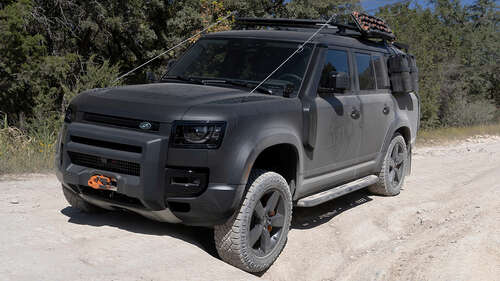
The Defender 130 currently sits at the top of Land Rover’s heap, with plenty of room for our team of four and gear. The 130’s naming no longer matches the wheelbase length, though, since the Defender 110 and 130 sit on the same 119-inch long chassis. But it still measures 13.4 inches longer than the 110 so, at first, I worried about approach and departure angles for any serious rock crawling. At least the long wheelbase might help with stability at higher speeds in the dirt, I figured—a maximum speed limit of 15 miles per hour made the latter entirely irrelevant.
A suite of different drive modes, by now common on even basic sports cars as well as 4x4s, actually trace back to Land Rover’s efforts in the 1990s to combine simple controls for suspension settings, throttle response, braking force, and more. In this era’s almost overwhelmingly digital Defender, the drive modes meant putting our trust in the truck’s total of 85 ECUs. We spent all day in 4Lo, given the speed limit, then spent some time experimenting with the Rock Crawl, Sand, Terrain, and Normal settings.
Rock Crawl prompts the air suspension to raise, while the transmission holds gears so the turbocharged inline-six can wind up into higher revs for additional torque. A hill descent system also turns on automatically, which led to plenty of unexpected braking on flatter sections of road—the system theoretically works better than a single brake pedal by controlling each wheel individually, but luckily can be turned off separately from the drive modes. And, via physical buttons on the Defender’s center console, I also fiddled with suspension height, traction control, and automatic engine stop-start. But strangely, the digital touchscreen displaying the off-road settings didn’t allow for manual control of the center or rear locking differentials, even as it showed the air suspension’s droop or compression in real time.

